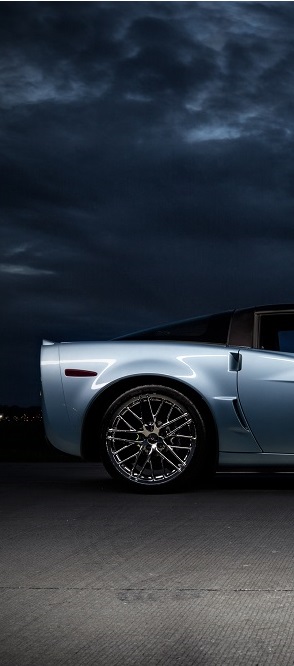

Chevrolet Camaro 1967 to 2002
Code name Panther was the way Chevy referred to the “pony car” they planned on unveiling to compete with the Mustang. The first model hit the show room floor in September 1966- it was not a Panther but a Camaro that Chevrolet chose to call the new model. The first letter of the name was a “C” in keeping the tradition of other model names before it, such as Corvair, Chevelle, Chevy II, and Corvette. When the press asked Chevrolet spokesmen to define the meaning of Camaro, the management replied “It is a small vicious animal that eats Mustangs.”

The first generation Camaro was made from 1967 to 1969 and is available as coupe or convertible style only. Chevrolet wanted to put distance between the new model and the failure of the Corvair with its rear engine design. The new Camaro with the more conventional designed rear wheel drive engine in front configuration automobile is on the newly styled “F” body platform. The engine compartment was designed to hold a large variety of power plants and the engine choices were huge. The car could be ordered with four different 6 cylinder engines or six different V8’s from 302 cu in (4.9 L) all the way up to a high performance 427 cu in (7.0 L) power plant. This original cars design would be the inspiration for the fifth generation of Camaro released in 2010.


In February 1970 the second generation was on the show room floor. This car was produced until 1981 and is possibly the best designed Camaro ever built. In 1971 Car and Track magazine said that the SS 350 Camaro was one of the top ten cars in the world. As a sign of the times the car became a bit larger with many visible design changes between 1974 and 1978 model years but still on the “F” body platform and with unibody. The Z28 design came and went but was reintroduced in the middle of 1977; it was the only Camaro to ever beat out its closest competitors – the Trans Am and the Mustang.

The third generation Camaro became available in 1982 and remained basically the same until 1992. At this time the first models became available that offered modern fuel injection instead of a carburetor. The third generation cars are 500 lbs (230 kg) lighter than the second generation counterparts. A standard transmission with a 4 cylinder engine was offered in 1982 and you could order that with a hatchback if it suited your lifestyle. The automobile could also be ordered with either 15” or 16”wheels coupled to a standard equipment five speed manual transmission or chose the optional four speed automatic or the turbo hydramatic option to turn those wheels.
 © Dikiiy | Dreamstime.com – Chevrolet Camaro 1985 Photo
© Dikiiy | Dreamstime.com – Chevrolet Camaro 1985 Photo
The 305 cu in motor was standard equipment. In 1985 the IROC-Z(stands for international race of champions) this fast beauty was on the market until 1990.Also in 1985 a center high mount stop lamp became mandatory for legal and insurance purposes; this lamp was mounted either in the rear window or on models so equipped it was in the rear spoiler. The 25th anniversary heritage package came out in 1992 thus car came with a 305 cu in (5.0 L) high output engine. The 1 LE performance pack usedo n the track was an option on street models starting in 1988. The B4C model “police package” was a Z28 with the more subdued RS styling was the last new offering of its generation and made it available in 1991. The fourth generation Camaro was produced from 1993 until 2002 – it retained the same “F-body platform” as the original 1967 model coupe with the buckets in front and a rear bench for two. In 1992 anti-lock brakes became standard equipment on all Camaro’s. The “T” roof and convertible models were available as options. The basic equipment motor from 1993 until 1995 was a 3.4 liter V6 with a push rod V6 and the V8 as options. Then in 1995 a 3.8 liter V6 became standard equipment with a small block 350 cu in V8 as standard equipment on the Z28 – this V8 was the same one introduced in the Corvette three years earlier. A four speed automatic transmission was standard on the Z28 or you could choose a six speed standard transmission for performance. Either one had optional all speed traction control available. The SS version had a small block 330 cu in was also on the market for 1996 and 1997 model years. In 1997 the exterior took some styling changes with an arc shaped rear wing for down force on the Z28 style but the interior underwent a revision. The 5.7 liter all aluminum engine was offered – it came with a 305 horse power rating. The SS model had improvements on the intake and exhaust systems. Bigger wheels and tires with stiffer suspension were the order of the day as well. The last year of production for generation four marked the thirty-fifth year of continuous production for the Camaro.
Republished by Blog Post Promoter
4 thoughts on “Chevrolet Camaro 1967 to 2002”
Comments are closed.








Sweeeet ride!!!
hahahahahaha there no such thing as a 66 camaro
MR/Miss/Ms/Mrs When-ever:
My My My some folks are critical-I changed the post but the Camaro was on show room floors in’66 so it is actually a ’66 1/2 but Chevy did call this Camaro a 1967
Editor
Kind of like the 64 1/2 Mustang